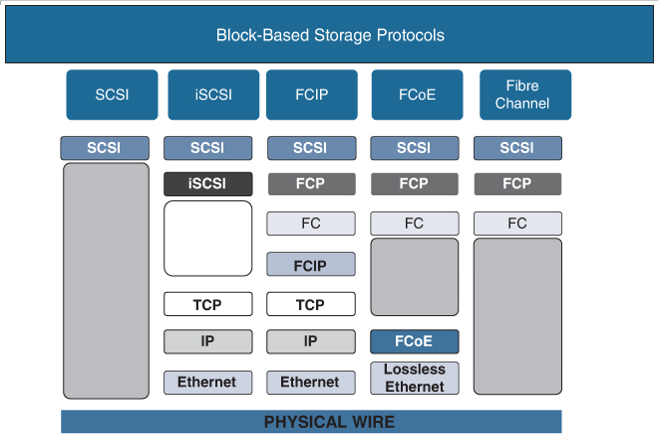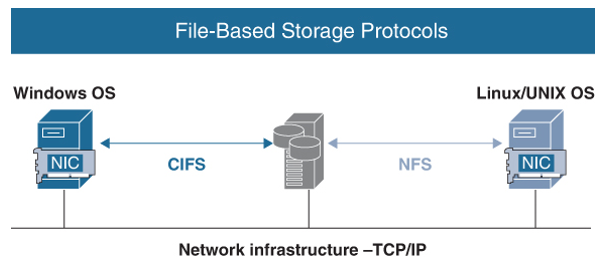Storage Protocols
With block-based storage, the data is sent to the storage systems and stored in blocks. The data is broken down into blocks of a specific, fixed size. The storage system decides where, physically, each block will be stored. When the initiator requests specific data, the storage system reads the blocks that form the data and return it to the server. The protocols used for the block-based storage communication use unique addressing in order for each block to be able to break down the data in blocks and transport it to the storage system, for the storage system to write the blocks, and to know to which piece of data the blocks belong. The addressing of the blocks is also important for the blocks to be put together in the correct order!
Multiple communication protocols are used in block-based systems, depending on where this communication takes place.
The block-based protocols used with local storage (the storage inside a PC) are as follows:
- Parallel ATA (PATA)
- Serial ATA (SATA)
- Parallel Small Computer Systems Interface (SCSI)
- Serial Attached SCSI (SAS)
The local storage is internal to the computers and uses a bus-based architecture. This means that the communication protocol uses a hardware bus to communicate between the operating system and the storage.
Figure 10-1 illustrates the different protocols using block-based storage and their transport options.

Figure 10-1 Block-Based Storage Protocols
When it comes to block-based storage network systems, the communications protocol used is the Small Computer Systems Interface (SCSI) protocol. The SCSI protocol uses different transport protocols and can be transmitted over existing IP networks or over dedicated transport infrastructures, referred to as storage area networks (SANs). The SANs are built from specialized Fibre Channel switches. The Cisco FC switches are the Cisco MDS family of products.
Here are some examples of SCSI transport protocols:
- FC protocol: The SCSI commands are encapsulated in FCP frames and transported between the initiators and the targets. The communication takes place in SANs.
- FC over IP (FCIP): The SCSI commands are encapsulated in FC frames, but the need to transport these frames over wide area networks, or over long distances, requires the FC frames to be encapsulated in TCP frames and carried over IP environments.
- FC over Ethernet (FCoE): The SCSI commands are encapsulated in FC frames, but the infrastructure is an IP environment, built with Ethernet switches that support the FCoE protocol. The FC frames are encapsulated in Ethernet frames and thus transported.
- Internal Small Computer Systems Interface (iSCSI): The SCSI commands are encapsulated in TCP packets and transported over an IP network. The Transmission Control Protocol (TCP) provides the security for the transmissions.
A file-based protocol is used to transfer files between a server and a client. The communication happens over a network. Note that with file-based storage, the atomic unit transferred is a file, whereas with the block-based storage, it’s a block of data. The protocols used for the file-based storage communication are the Network File System (NFS) on UNIX/Linux systems and Server Message Block (SMB), originally developed by IBM Corporation, but later adopted and enhanced by Microsoft, Intel, IBM, 3Com, and others. The most popular version (dialect) of SMB is the Common Internet File System (CIFS).
Figure 10-2 shows the communication of file-based protocols.

Figure 10-2 File-Based Storage Protocols
The CIFS and NFS protocols communicate over TCP/IP. Because of this, latency is high.
Which network storage approach (block- or file-based) is used and which protocols are used depend on the specific storage needs. The block-based storage characteristics are as follows:
- Benefits:
- Performance: Block-based storage uses dedicated, high-capacity hardware in combination with secure and fast protocols, such as FC, which provides a very high number of input/output operations per second (IOPS).
- Security and data safety: The protocols used to transfer data blocks are designed to create secure, reliable, and safe communication between the initiators and the targets.
- Scalability and flexibility: The storage systems’ capacities and the SAN infrastructures allow for rapid scaling to keep up with the growth and demands of the organizations.
- Easy file modifications: With block-based storage, when a file is changed, the modifications in the storage system are made at the level where the blocks are changed, not the whole file.
- Drawbacks:
- Cost: Block-based network storage systems require specialized, dedicated infrastructures—the SANs. Also, the initiators and the targets need to have specialized communication adapters, which are called host bus adapters (HBAs), or network adapters with support for iSCSI.
- Initiator binding: The different initiators, depending on their operating system, access the resources of the storage system in different ways.
The file-based storage characteristics are as follows:
- Benefits:
- Simplicity: File-based storage is simpler to implement and does not require specialized hardware.
- File sharing: File-based storage uses sharing to provide access to file resources to multiple users.
- Common protocols: The SMB/CIFS and the NFS are components of the Windows and Linux/Unix operating systems.
- Cost: File-based storage allows for cheaper means to share backup/archive files, as there is no need for specialized infrastructure or communication adapters.
- Drawbacks:
- Latency and bandwidth: The communication is over IP networks in the data center, and the speeds and latency might not be optimal.
- Traffic isolation: Traffic isolation is based on the use of VLANs, which might pose a security issue.